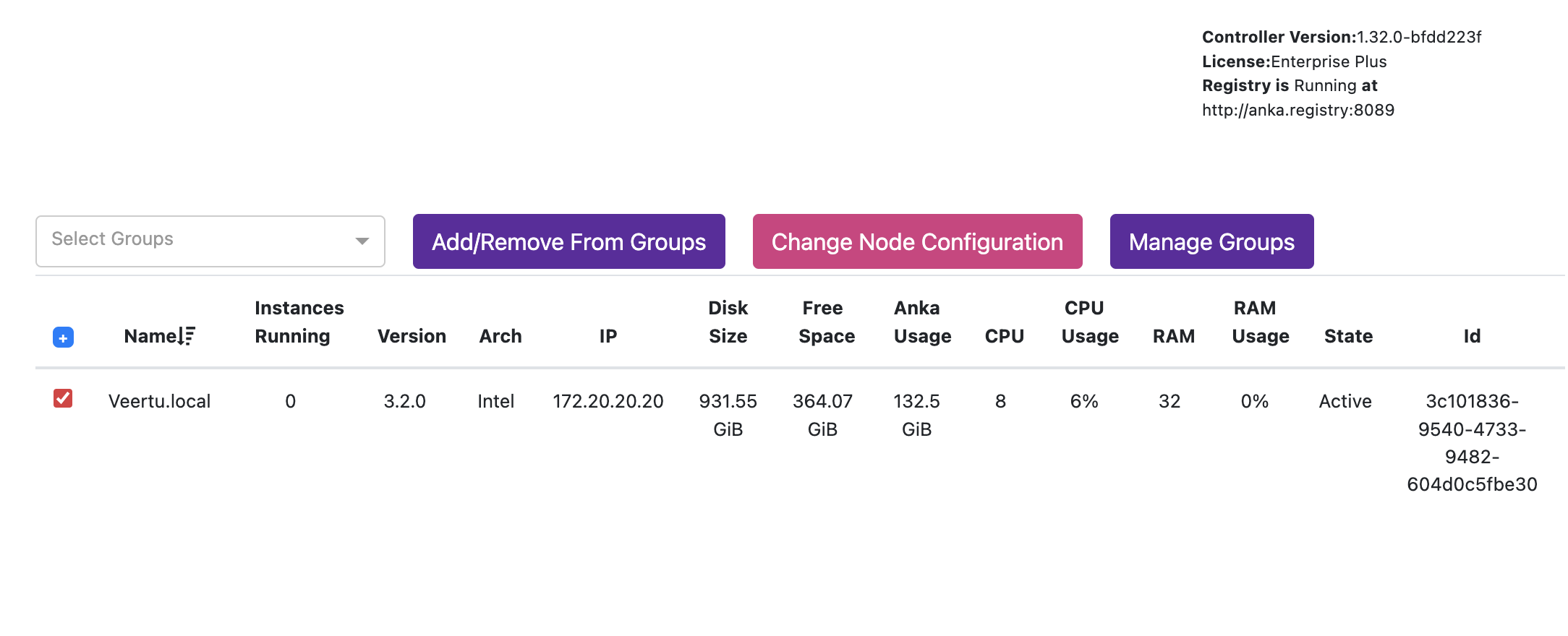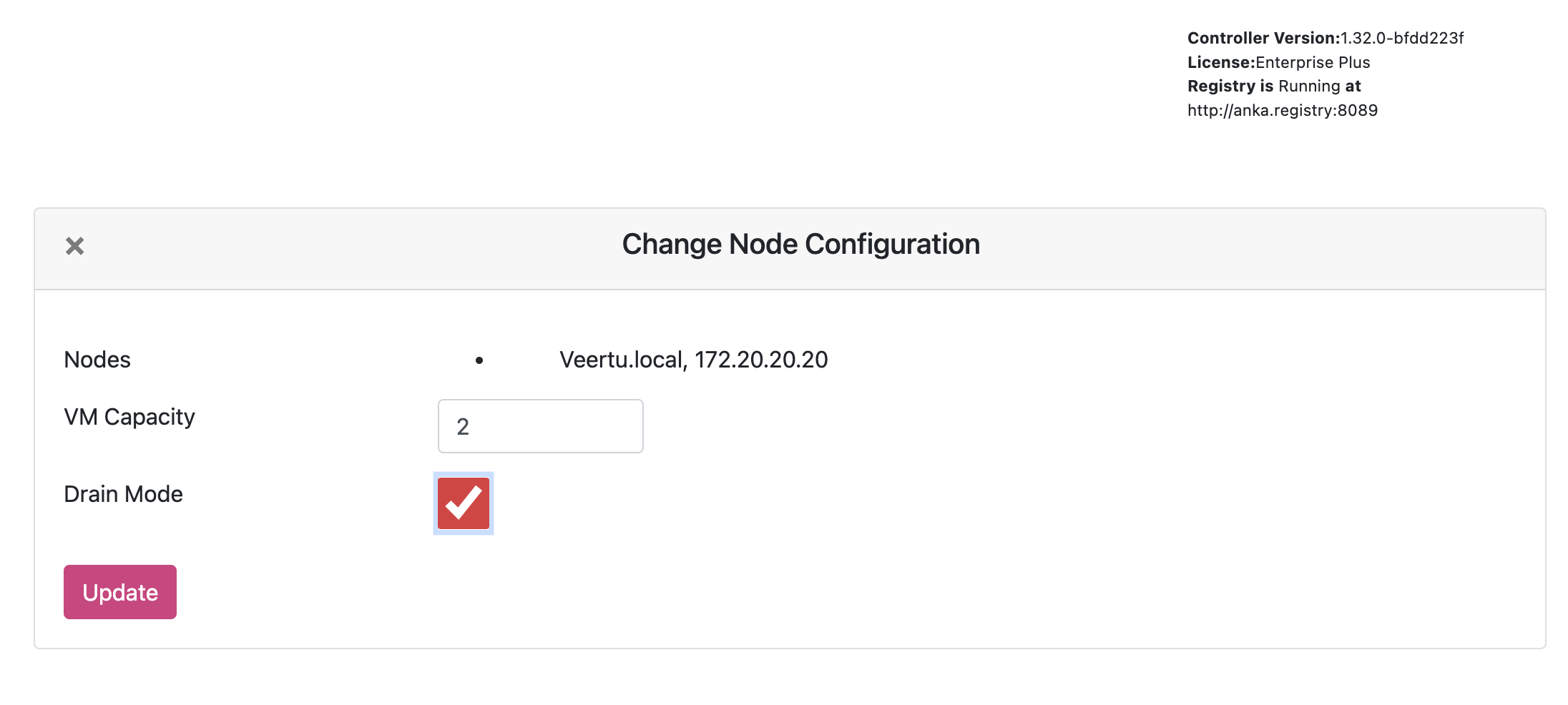Anka Build Cloud Controller & Registry Version 1.32.0
Drain Mode
Starting in 1.32.0, users can now use the Change Node Configuration feature through the UI to control Capacity as well as change the Anka Node to Drain Mode. This will allow VMs to finish their jobs, but not accept any new VM start tasks.


You can also use the API:
❯ curl -X POST http://anka.controller:8090/api/v1/node/config -d '{"node_id": "3c101836-9540-4733-9482-604d0c5fbe30", "drain_mode": true}'
{"status":"OK","message":""}
Certificate Revocation
Starting in 1.32.0, users can now revoke certificates without needing to change the CA or permissions.
Generating the Certificate Revocation List
- Locally on your machine you’ll create
openssl.cnf(anywhere on your machine), containing various definitions:
[ ca ]
default_ca = CA_default # The name of the CA configuration to be used.
# can be anything that makes sense to you.
[ CA_default ]
dir = . # Directory where everything is kept
certs = $dir # Directory where the issued certs are kept
crl_dir = $dir # Directory where the issued crl are kept
database = $dir/index.txt # database index file.
#unique_subject = no # Set to 'no' to allow creation of
# several certificates with same subject.
new_certs_dir = $dir # Default directory for new certs.
certificate = $dir/anka-ca-crt.pem # The CA certificate
serial = $dir/serial # The current serial number
crlnumber = $dir/crlnumber # The current crl number
# must be commented out to leave a V1 CRL
crl = $dir/crl.pem # The current CRL
private_key = $dir/anka-ca-key.pem # The private key
RANDFILE = $dir/.rand # private random number file
x509_extensions = usr_cert # The extentions to add to the cert
name_opt = ca_default # Subject Name options
cert_opt = ca_default # Certificate field options
default_days = 365 # how long to certify for
default_crl_days= 30 # how long before next CRL
default_md = sha1 # use public key default MD
preserve = no # keep passed DN ordering
policy = policy_match
- Next, create
index.txtandcrlnumberand store them in a centralized location:
Any revocations must happen against the latestindex.txtandcrlnumber(openssl.cnfis optional). It’s best to store these in a repo or somewhere that admins revoking can pull the latest versions and then commit them once complete.
touch index.txt # stores revoked certificates database
echo "01" > crlnumber # needs to be only initialized once
- Generate your first Certificate Revocation List (a.k.a “CRL”):
openssl ca -gencrl \
-config openssl.cnf \
-keyfile anka-ca-key.pem \
-cert anka-ca-crt.pem \
-out crl.pem \
-crldays 365
- If Certificate Authentication is enabled for both the Controller and Registry, you’ll need to set
ANKA_CRLin both configs to the Revocation List File (.pem). If using Docker, you’ll need to attach a mount/volume that contains this file and target the destination/location inside of the container. - Generate your client certificates with
opensslas you normally would, using the same root CA you used to generate the CRL.
Revoking a certificate
- When you need to revoke a certificate, you can use the following to add the cert to the
index.txtdatabase file:
openssl ca -config openssl.cnf \
-revoke node-Veertu.local-crt.pem \
-keyfile anka-ca-key.pem \
-cert anka-ca-crt.pem
- Once revoked, you must re-generate the CRL file and update it on the Controller and Registry, restarting them once updated:
openssl ca -gencrl \
-config openssl.cnf \
-keyfile anka-ca-key.pem \
-cert anka-ca-crt.pem \
-out crl.pem \
-crldays 365
Some things to note
- You can check if a certificate is revoked with
openssl verify -crl_check -CAfile anka-ca-crt.pem -CRLfile crl.pem node-Veertu.local-crt.pem. - The
index.txt,crlnumber, and certs generated should be stored in a centralized location. We recommend a repo or a server with openssl on it that only admins have access to. Any changes made should be checked into the repo so that others can pull them and start from the latest version of the revocation DB (index.txt). - If the
crl.pemexpires, the controller and registry will fail. - The
crl.pemmust be generated with CA Root cert that the Controller and Registry are using.